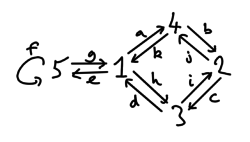Difference between revisions of "M(8,5,7)"
| Line 33: | Line 33: | ||
|O-morita-frob = 1 | |O-morita-frob = 1 | ||
|Pic-O = <math>1</math><ref>See [[References|[EL18c]]]. Also shown by Eisele by a different method.</ref> | |Pic-O = <math>1</math><ref>See [[References|[EL18c]]]. Also shown by Eisele by a different method.</ref> | ||
| + | |PIgroup = <math>(C_2 \wr S_4) \times C_2</math><ref>See 8.7 of [[References|[Ru11]]], which uses GAP.</ref> | ||
|source? = No | |source? = No | ||
|sourcereps = | |sourcereps = | ||
| Line 38: | Line 39: | ||
|k-derived = [[M(8,5,6)]], [[M(8,5,8)]] | |k-derived = [[M(8,5,6)]], [[M(8,5,8)]] | ||
|O-derived-known? = Yes | |O-derived-known? = Yes | ||
| − | |coveringblocks = | + | |coveringblocks = M(8,5,7) (complete) |
| − | |coveredblocks = | + | |coveredblocks = M(8,5,7) (complete) |
| + | |pcoveringblocks = [[M(16,14,14)]] (complete) | ||
}} | }} | ||
| − | |||
| − | |||
== Basic algebra == | == Basic algebra == | ||
Revision as of 18:21, 5 December 2018
| Representative: | [math]B_0(kJ_1)[/math] |
|---|---|
| Defect groups: | [math]C_2 \times C_2 \times C_2[/math] |
| Inertial quotients: | [math]C_7:C_3[/math] |
| [math]k(B)=[/math] | 8 |
| [math]l(B)=[/math] | 5 |
| [math]{\rm mf}_k(B)=[/math] | 1 |
| [math]{\rm Pic}_k(B)=[/math] | |
| Cartan matrix: | [math]\left( \begin{array}{ccccc} 8 & 4 & 4 & 4 & 4 \\ 4 & 4 & 3 & 3 & 1 \\ 4 & 3 & 4 & 2 & 2 \\ 4 & 3 & 2 & 4 & 2 \\ 4 & 1 & 2 & 2 & 4 \\ \end{array} \right)[/math] |
| Defect group Morita invariant? | Yes |
| Inertial quotient Morita invariant? | Yes |
| [math]\mathcal{O}[/math]-Morita classes known? | Yes |
| [math]\mathcal{O}[/math]-Morita classes: | [math]B_0(\mathcal{O}J_1)[/math] |
| Decomposition matrices: | [math]\left( \begin{array}{ccccc} 1 & 0 & 0 & 0 & 0 \\ 1 & 0 & 0 & 0 & 1 \\ 1 & 1 & 1 & 0 & 0 \\ 1 & 1 & 0 & 1 & 0 \\ 1 & 1 & 1 & 1 & 0 \\ 1 & 0 & 0 & 1 & 1 \\ 1 & 0 & 1 & 0 & 1 \\ 1 & 1 & 1 & 1 & 1 \\ \end{array}\right)[/math] |
| [math]{\rm mf}_\mathcal{O}(B)=[/math] | 1 |
| [math]{\rm Pic}_{\mathcal{O}}(B)=[/math] | [math]1[/math][1] |
| [math]PI(B)=[/math] | [math](C_2 \wr S_4) \times C_2[/math][2] |
| Source algebras known? | No |
| Source algebra reps: | |
| [math]k[/math]-derived equiv. classes known? | Yes |
| [math]k[/math]-derived equivalent to: | M(8,5,6), M(8,5,8) |
| [math]\mathcal{O}[/math]-derived equiv. classes known? | Yes |
| [math]p'[/math]-index covering blocks: | M(8,5,7) (complete) |
| [math]p'[/math]-index covered blocks: | M(8,5,7) (complete) |
| Index [math]p[/math] covering blocks: | M(16,14,14) (complete) |
Contents
Basic algebra
Quiver: a:<1,4>, b:<4,2>, c:<2,3>, d:<3,1>, e:<1,5>, f:<5,5>, g:<5,1>, h:<1,3>, i:<3,2>, j:<2,4>, k:<4,1>
Relations w.r.t. [math]k[/math]:
Other notatable representatives
Projective indecomposable modules
Labelling the simple [math]B[/math]-modules by [math]1,2,3,4,5[/math], the projective indecomposable modules have Loewy structure as follows:
[math]\begin{array}{ccccc} \begin{array}{c} 1 \\ 3 \ 4 \ 5 \\ 1 \ 2 \ 1 \ 2 \ 1 \\ 3 \ 3 \ 4 \ 4 \ 5 \ 5 \\ 1 \ 2 \ 1 \ 2 \ 1 \\ 3 \ 4 \ 5 \\ 1 \\ \end{array}, & \begin{array}{c} 2 \\ 3 \ 4 \\ 1 \ 2 \ 1 \\ 3 \ 4 \ 5 \\ 1 \ 2 \ 1 \\ 3 \ 4 \\ 2 \\ \end{array}, & \begin{array}{c} 3 \\ 1 \ 2 \\ 3 \ 4 \ 5 \\ 1 \ 2 \ 1 \\ 3 \ 4 \ 5 \\ 1 \ 2 \\ 3 \\ \end{array} , & \begin{array}{c} 4 \\ 1 \ 2 \\ 3 \ 4 \ 5 \\ 1 \ 2 \ 1 \\ 3 \ 4 \ 5 \\ 1 \ 2 \\ 4 \\ \end{array}, & \begin{array}{ccc} 5 \\ 1 \ 5 \\ 3 \ 4 \\ 1 \ 2 \ 1 \\ 3 \ 4 \ 5 \\ 1 \\ 5 \\ \end{array} \end{array} [/math]
Irreducible characters
All irreducible characters have height zero.
Back to [math]C_2 \times C_2 \times C_2[/math]
